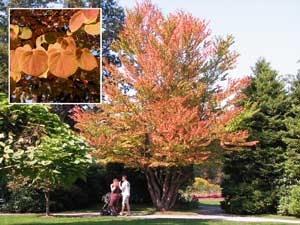Resource Library
Plant of the Week: Katsura Tree
The University of Arkansas System Division of Agriculture does not promote, support or recommend plants featured in "Plant of the Week." Please consult your local Extension office for plants suitable for your region.
Plant of the Week
Katsura Tree
Latin: Cercidiphyllum japonicum

Some trees remain uncommon in parks and gardens even though they have outstanding ornamental value. One of these, the Katsura tree (Cercidiphyllum japonicum) of Japan and China, is a beautiful specimen with an interesting history, yet it’s still uncommon enough that its discovery always causes a bit of excitement.
Cercidiphyllum is a monotypic family with two species, but only the Japanese species is grown as an ornamental. Like ginkgo, the Katsura tree once ranged over a wide swath of the northern hemisphere. Fossil records have been discovered in both Europe and North America. The tree vanished from the floras of Europe and North America during the Pleistocene epoch of glaciation that began about 1.8 million years ago and ended about 11,500 years ago, about the time humankind started developing agriculture in the “Fertile Crescent” in the Middle East.
In Japan, Katsura is an important timber species with the soft, white wood used primarily for cabinetry and paneling. In the moist valleys of Japan and south-central China this deciduous tree can grow to heights of more than 100 feet, but in cultivation, it’s always shorter, seldom reaching more than 30 to 40 feet in height and spread. Katsuras are primarily propagated by seed so there is considerable variation in growth forms, but most tend to be multiple-trunked or at least low-branched.
Katsura is called Cercidiphyllum because its rounded, heart-shaped leaves resemble those of redbuds (Cercis) but are only about two-thirds as large. In the spring, the opposite leaves are tinged with red as they emerge; in the fall, they turn yellow to orange.
Katsuras are dioecious with male and female trees. The flowers appear before the leaves, but lack petals, so they’re of little ornamental interest. The small banana-shaped fruit pods are small but can be produced in abundance if a male is around for pollination.
Katsura trees were introduced to the United States by Thomas Hogg Jr. about 1865 when he shipped home seeds to his brother James who operated the family nursery on Broadway in Manhattan. Abraham Lincoln had appointed Thomas a United States marshal in 1862 with a diplomatic mission in Japan. He served there for 10 years and introduced several noteworthy garden plants and one notorious plant, the kudzu vine.
E. H. “China” Wilson was the first to find Cercidiphyllum in China in 1907. Traveling in northwest Szechwan province, he reported the forests of the region were being systematically stripped of their trees. In one area, he found a park-like stand of Cercidiphyllum with trunks 2 to 3 feet in diameter that had regrown after the original trees were cut. The trunks of the original trees remained as rotted hulks. The largest of these had a trunk diameter of 17.5 feet!
Katsura trees are small enough to use in most contemporary landscapes. If allowed to grow as a multi-trunked specimen, they will be as wide as tall, but if pruned at an early age to one main trunk, they develop a more vertical habit. Their rarity makes them ideal for a specimen near a patio or entryway.
Katsura trees are hardy in zones 4 through 8. It should be transplanted as a container-grown tree in early spring into sunny areas with a rich, well drained but moist soil. This species has poor drought tolerance so keep a watch on the water needs of the plants during drought periods. It should not be used in areas subject to prolonged summertime droughts. It has no serious insect or disease pests.
By: Gerald Klingaman, retired
Extension Horticulturist - Ornamentals
Extension News - November 2, 2007
The University of Arkansas System Division of Agriculture does not maintain lists of retail outlets where these plants can be purchased. Please check your local nursery or other retail outlets to ask about the availability of these plants for your growing area.